Sennheiser AVX
Digital Wireless Microphone System for Audio for Video
Author and Photos: Peter Kaminski
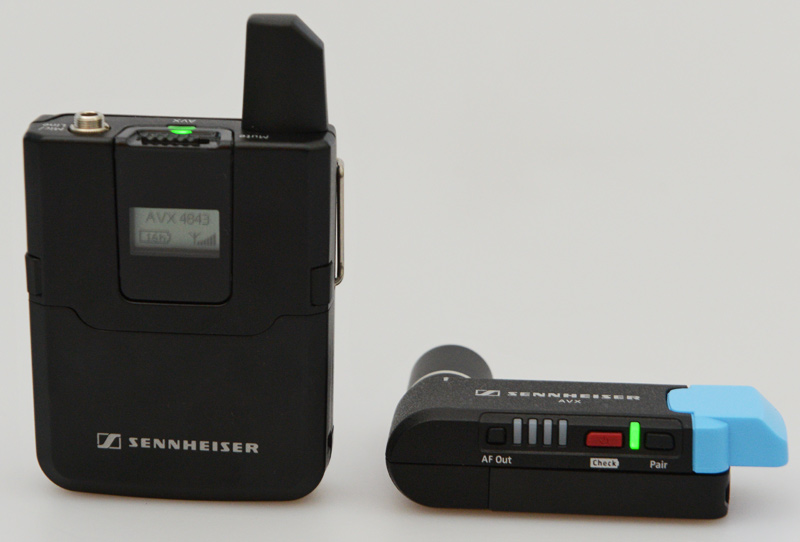
At the NAB show in April 2015, Sennheiser unveiled its AVX digital wireless audio system for video cameras. The system differs in many points from previous wireless microphone systems used for audio for video. There is plenty for us to report about.
DECT
The first new feature is the transmission format and frequency range. This is a vitally important point in the wake of restrictions regarding frequency allocations for wireless microphone systems. The AVX developers decided against using the UHF frequency range or the LTE gap and opted instead for DECT. Initially, DECT stood for Digital European Cordless Telephony. The aim was to introduce a modern standard for wireless telephony. However, it soon became clear that the system offers more potential than just for wireless telephones. Today, DECT therefore stands for Digital Enhanced Cordless Telecommunications. In the meantime, DECT is used for industrial communication and for intercom systems on stage, as well as for remote-controlled systems, for example in the form of remote-controlled power sockets, etc.
DECT was defined as a standard by ETIS (European Telecommunications Standards Institute). In 1992, DECT was subsequently introduced and a frequency range was also specified for this application throughout Europe. CEPT recommended that telecommunications authorities should not demand any fees or licences for using DECT. As a result, DECT can be used throughout Europe free of charge.
The frequency range in Europe is 1880 to 1900MHz, in other words a 20MHz segment. However, DECT has also become established beyond Europe's borders. For example, DECT can also be used in the same frequency range in India, Indonesia, Hong Kong, Singapore, Malaysia and Australia. In North and South America however, the frequency range for DECT is 1,920 to 1,930MHz (with the exception of Brazil, where it is 1,910 to 1,920 MHz). In Japan it is 1,893 to 1,906MHz and in Taiwan 1,880 to 1,895MHz.
DECT also includes dynamic frequency allocation. This means that users need not worry about selecting the right operating frequency, as this is done by the end device itself. If interference is detected on one channel, the frequency is automatically changed. Transmission is bidirectional, in other words in both directions, although the data transfer rate can differ in the two directions. DECT provides 24 time slots in a 10-millisecond frame, and these can be used as required for either direction (up and down stream). DECT portable devices can be connected via a base station, something which we are familiar with from cordless phones, but a point-to-point connection is also possible. The maximum allowed power is 250mW.
Concept and Technology
But let's now return to Sennheiser's AVX system. The requirements to be met by high-quality audio transmission are, of course, significantly higher than for the audio bandwidth of a DECT telephone, which is limited to 7 kHz. This is achieved by a number of measures: firstly by the above-mentioned asymmetry of the data rates (the return path requires less bandwidth than the main path in an application), by bundling several channels and by using audio coding with data compression. In AVX, the three-fold channel width of a normal DECT channel is used.
As a result, the system offers an audio transmission range of 20Hz to 20kHz with a sampling rate of 48kHz and a resolution/word width of 24bits. A signal-to-noise ratio of over 90dB (A-weighted) is achieved. Instead of the 64-bit or 128-bit encryption usually used for DECT, AVX uses tap-proof 256-bit AES encryption.
The latency of the AVX system is 19 milliseconds and is essentially determined by the audio codec. The codec is a speech-optimised codec based on the CELT codec. It was specially adapted and optimised to Sennheiser's requirements. CELT (Constrained Energy Lapped Transformation) is itself based on the speech-optimised CELP codec (Code-Excited Linear Prediction), which was developed for very low data rates. Unlike CELP, CELT works exclusively on the frequency domain and, in spite of being optimised for speech, it supports both speech and music.
SK AVX Bodypack Transmitter

The compact bodypack transmitter (65x100x24mm, 130g) comes in a metal housing and has a 3.5mm threaded mini jack socket (Mic/Line) familiar from the G3 system for secure screw-attachment of the microphone connector. The input level is 2.2Vrms for a microphone and 3.3Vrms for a Line level (coded via the plug). The frequency response of the bodypack transmitter is 50Hz to 20kHz.
The display shows the remaining operating time and the field strength at the receiver (via the RF remote channel) as well as the name of the wireless connection in the form of the last four digits of the serial number.
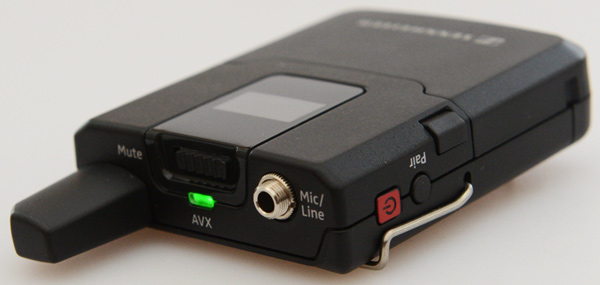
There is no flap to access the controls because all control elements are directly accessible from outside. There are also only three control elements, namely an on/off button, a further button to initiate pairing or to identify the linked receiver, and a Mute switch at the top next to the short antenna. An LED indicates the connection status (green: linked, red: not linked). There is no control for the input sensitivity as this is set automatically. We will go into more detail below in the section on practical application.

The bodypack receiver is operated as standard with a BA 30 lithium-ion rechargeable battery pack with a capacity of 2.030 mAh, providing a typical operating time of 15 hours. When 15 minutes of charge remains, an indicator LED on the transmitter starts to flash red. As an option, a battery adapter for two standard AA batteries is also available. These will power the bodypack transmitter for around 11 hours. Charging is carried out via a micro USB socket, which has a rubber cover to protect it from dust. The bodypack transmitter comes with a plug-in mains adapter and a USB charging cable.
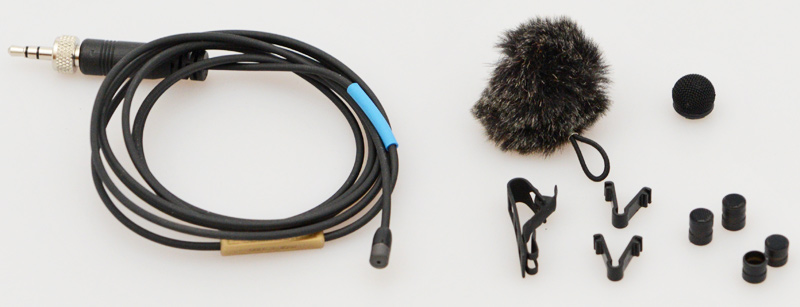
It is also interesting to take a look at the accessories supplied with the MKE 2 microphone (see photograph above). These include a clip to attach the microphone to clothing, two microphone cable holders, a metal windshield and a fur windshield, as well as two frequency response caps for a slight (small cap) or strong (large cap) increase in treble response.
The ME 2 microphone comes with a microphone clip and a small foam windshield. Both the ME 2 and the MKE 2 have an omnidirectional pick-up pattern.
SKM AVX Handheld Transmitter

The handheld transmitter (length 275mm with microphone module and batterie pack) is available in two different sets, either without (see photo above) or with a Mute switch, which is located below the LC display. At the lower end of the handheld transmitter are the on/off switch with an LED indicator and the Pair button. There are no other controls. The frequency response of the handheld transmitter is also 50Hz to 20kHz..

The handheld transmitter consists of an SKM AVX-835 transmitter section made of metal, a screw-on MMD 835-1 microphone module with a cardioid pick-up pattern and a BA 10 lithium-ion battery pack, which is inserted into the transmitter section (see photo above). The set also includes a microphone stand clamp.
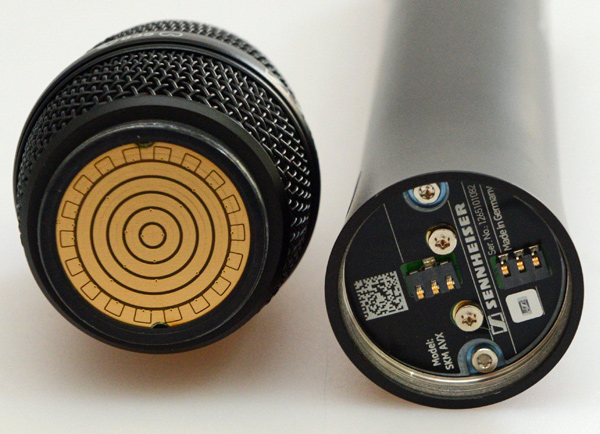
The handheld transmitter is also charged via a micro USB socket (see photo below). Operating time is typically 15 hours. Here too, the LED flashes red when the capacity of the receiver's battery pack is only sufficient for a maximum of 15 minutes of operation.
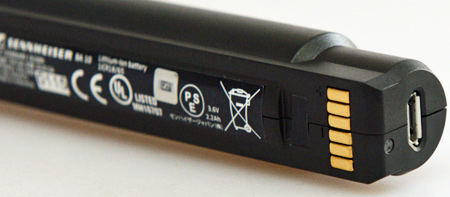
As an alternative, the handheld transmitter can also use a battery holder with two AA batteries, providing the microphone with an operating time of 11 hours when alkaline batteries are used.
EKP AVX Receiver
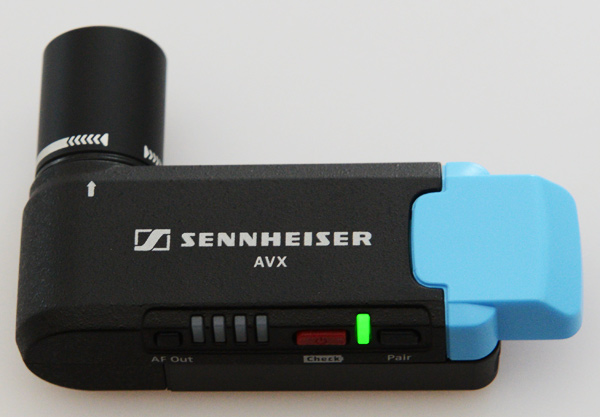
The housing of the AVX receiver has a completely new design. The receiver is ultracompact (length 81mm, weight a mere 87g with battery) and is fitted with an XLR connector which is integrated into the housing and which is rotatable by 360 degrees. This enables the receiver to be plugged directly onto the camera's XLR audio input.
This component too has an on/off/check push-button switch with an LED indicator. Short-pressing the button will display the charge status of the accupack on the four-step LED display. There is, of course, also a Pair button. The audio output level output can be adjusted in four stages via the AF Out button (0, -10, -20 and -30dBu). Short-pressing the button will indicate the current output level on the four-step LED display.
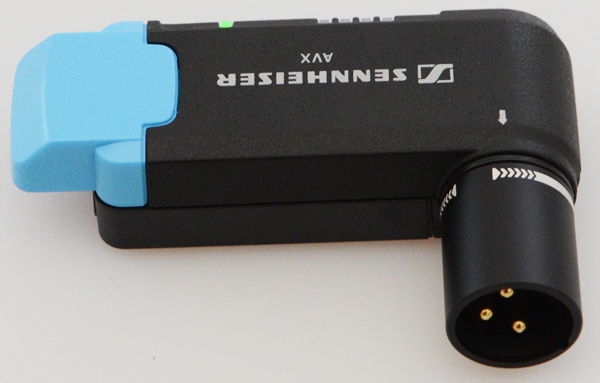
The battery on the receiver is also more compact and has a typical operating time of at least four hours. Thebattery pack can also be recharged during operation via the micro USB socket. An interesting feature is that the 48V phantom power supply at the camera input is used to activate the receiver or to switch it to stand-by when phantom power is deactivated. When the lowermost LED of the four-step LED display flashes red, the capacity of the accupack is only sufficient for less than 15 minutes of operation.
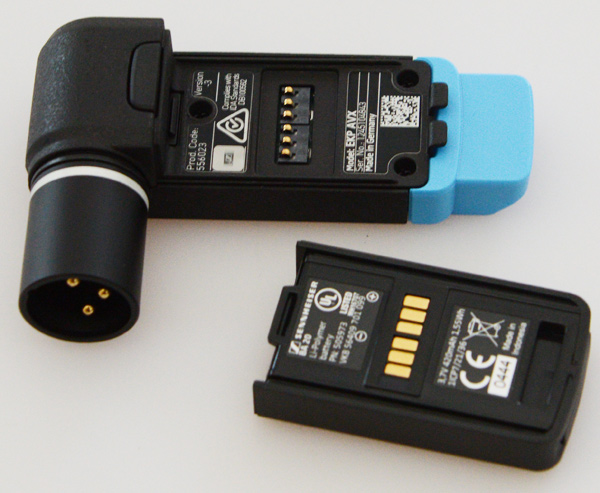
In addition to a USB charging cable and a plug-in power supply/charger, the receiver also comes with a hot shoe adapter for attachment to a camera without an XLR audio input. The set also includes a belt clip to enable the receiver to be worn on the body.
Interview
We had the opportunity to talk to Sven Boetcher, Portfolio Manager Broadcast & Media at Sennheiser, who gave us more information.

proaudio.de: Perhaps you could tell us something about the history and development of AVX.
Sven Boetcher: In spite of the great success of evolution wireless G3, we wanted to question the status quo for this new development. We sat down together with video journalists and videographers and asked them about the challenges they faced in their everyday work. A particular point they focused on was the camera receiver. They expressed a desire for greater user-friendliness, more compact equipment and easier working in general with wireless equipment.
proaudio.de: Was that the reason why you chose the DECT standard for transmission?
Sven Boetcher: No, not necessarily. The users felt that fast and easy application was important above all. When filming, they did not want to get held up with audio and frequency settings but wanted to concentrate immediately on the picture and to start filming. It was only later that we searched for the suitable technology. The DECT basis proved to be a good solution, and then we began to work on the best possible sound.
proaudio.de: Can we assume that AVX is also equipped with a diversity function?
Sven Boetcher: Both ways have diversity, as the transmitter is also a receiver, and vice versa, because the components exchange information with each other, for example about the suitable frequency. Because of the close proximity of the antennas, we work with polarisation, which means that the antennas are at an angle of 90 degrees to one another.
proaudio.de: What kind of audio codec is used for AVX?
Sven Boetcher: It is a speech-optimised codec based on the CELT codec, which we have adapted specially for our requirements, in other words we have refined it. We chose speech optimisation because it is ideal for this application case. Our target group works with interviews, with speech.
proaudio.de: Is there some kind of dynamic control?
Sven Boetcher: In the normal operating range, the system passes on the signal unchanged. For extreme signal levels, there is a kind of built-in "airbag". If an interview partner shouts into the microphone, we carefully adjust the signal, preventing the signal from clipping and the user from getting an unusable signal.
proaudio.de: Are the microphones compatible with those of the evolution wireless G3 series?
Sven Boetcher: All microphone capsules of the evolution wireless G3 series can also be used for AVX. As a model with an omnidirectional pick-up pattern is ideal for interview situations, we have introduced an additional microphone head, the MMD 42 capsule. It is based on our MD 42 reporter's microphone.
proaudio.de: Are there sets with different miniature capsules?
Sven Boetcher: Yes, there are bodypack sets with the ME 2 and the more professional MKE 2. An MKE 1 can also be used with the system. We are currently working on a list of compatible products, as one cannot connect every type of microphone due to the pulsed digital transmission.
proaudio.de: Will there be a charging station or is a different charging station from another product available for the AVX receiver?
Sven Boetcher: A charging station is not planned, because we wanted to make everything as simple and as transportable as possible. For that reason, the accupack has a USB charging socket which works with every USB charging cable, every power bank and every mobile phone charger. It couldn't be easier than that.
proaudio.de: Are other components planned, for example a plug-on transmitter?
Sven Boetcher: We are waiting for feedback from our users. A plug-on transmitter is not planned at the moment. However, AVX is an important platform for us and we will precisely monitor the wishes and needs of our customers.
Practical Application
In the meantime, we have used the AVX system for a whole series of video shootings, both indoors and for outside filming, and we would like to report on our own experiences in the following. At the same time, we often used a G3 100 from Sennheiser in parallel for comparison purposes.
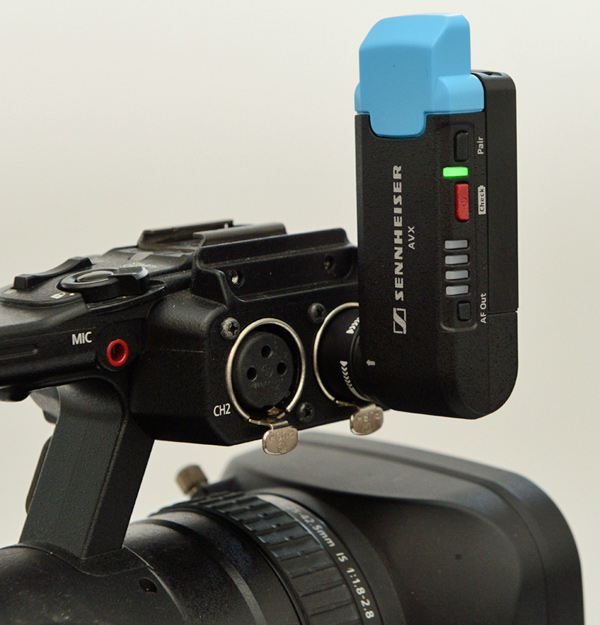
To pair the receiver and transmitter, one first has to short-press the Pair button on both units, and after a few seconds, the status LED on both the transmitter and receiver will light up green, signalling that a wireless link has been successfully established. Pairing takes place via a bidirectional wireless link. When the units are switched on next time, they will remember the pairing. Only when one needs to pair with a different AVX component is it necessary to carry out the pairing process again. Everything works perfectly and quickly. In fact, extremely user-friendly operation is one of the highlights of this system. But we will talk more about that below.
The rotatable XLR connector on the receiver housing allows the receiver to be easily connected directly to any camera with an XLR audio input (see photo above). No hot shoe adapter and in particular no connecting cable from the receiver to the camera are required. That is an extremely practical feature. The fact that the XLR connector is rotatable means that is always possible to find the optimum position. For DSLR cameras or video cameras without an XLR audio input, it is necessary to use the hot shoe adapter that comes with the set. There are, of course, also DSLR cameras with different supply voltages for electret microphones. However, these cannot be used to automatically switch off the receiver when the camera is switched off. This works only when 48V phantom power is used.
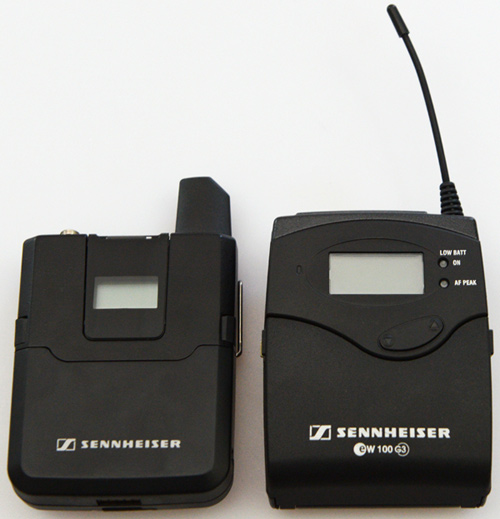
When compared directly to the frequently used ew 100 G3 receiver (see photo above), the bodypack transmitter of the AVX system is much more compact. In particular, it is thinner and has a solid antenna enclosure. This makes it much easier to transport, as one does not need to worry about the antenna getting bent in the carrying case.
The attachable metal windshield for the MKE 2 attenuates wind noise by approximately 10dB. Additionally fitting the fur windshield provides a further reduction of 10dB. The fur windshield is fitted over the metal windshield. Overall, the more professional MKE 2 Lavalier microphone is highly recommended, as it also offers excellent audio results in different conditions and when fitted with the frequency response caps to increase treble response.
Let's now turn to evaluating the system's sound quality. The sound of the AVX is in no way inferior to that of the ew 100 G3. It is, of course, not easy to compare the two because the AVX does not have a compander but uses digital transmission with audio data compression. However, the codec works absolutely convincingly. Even for sounds or music, a high quality is achieved, which means that one should not misinterpret the emphasis on speech optimisation.
The system's automatic level control is actually only audible if AVX has been incorrectly set. The best way is to set the camera input sensitivity to microphone, set the gain control on the camera to middle and then set the level with the four gain stages on the receiver in such a way that there is at least 12 dB of headroom for the peak signals during normal conversation in order to absorb the peaks. Individual fine tuning can then be performed if necessary on the camera's gain control. If the gain is set too high, with the result that one is often at the zero dB limit, the level control then becomes audible. However, if the headroom is taken into consideration, the automatic level control works very well. If a high level peak occurs only occasionally, this is controlled very well, without artefacts becoming audible. Therefore, one needs to pay much less attention to level control when using AVX than with systems that have purely manual level adjustment, where clips can sometimes also result in an unusable audio signal. AVX is much more tolerant in this respect.
Now we come to an evaluation of the RF transmission. Video recordings often use the UHF-LTE gap from 823 to 832 MHz or the ISM range from 863 to 865 MHz, as these are license-free and also nationally available, and in the latter case even internationally available. Increasingly however, problems are caused by interference, such as an occasional click or mute, as LTE devices close to the wireless receiver may well impair the signal. This cannot always be ruled out, especially at crowded public events. In addition, there are increasing numbers of devices in the ISM range that can also be the cause of brief interference. The situation is quite different, however, in the DECT range and therefore for the Sennheiser AVX. During all of the tests that we carried out, we did not have a single case of interference. Even in environments with an increased number of DECT devices in close proximity, wireless transmission worked perfectly.
The range of the DECT-based Sennheiser AVX cannot be compared with that of a Sennheiser ew 100 G3 and is lower. But in practice, that is absolutely no problem for the intended application for video recordings, as the interviewer and interview partner are usually close to the camera and the AVX receiver. The ew 100 G3 has a much wider range. The range is particularly reduced by the much higher operating frequency of approximately 1,900MHz – in other words more than twice as much as in the license-free UHF frequency range – when transmitting through walls and buildings. But in this case too, we can assume that the AVX transmitter is in the same room during camera recordings. The reduced range compared with the ew 100 G3 can therefore be accepted without problems for the intended application. The advantages of automatic and dynamic frequency selection plus the absolute resistance to interference in practical application are ultimately the decisive factors for our absolutely positive verdict on the Sennheiser AVX.
The latency of 19 milliseconds is acceptable, with the result that one does not need to use delay compensation. For a recording with 50p or 60p, that corresponds approximately to one frame, which can be seen as acceptable. Some cameras, especially in the DSLR field, also have a delay between the image and the sound. If necessary, one has to consider the overall situation. In the professional video cameras that we employed, we did not use compensation or re-synchronise the audio. If one wants to precisely synch the audio, one can, of course, work with a clapperboard.
We can say a little more about practical operation. The charging time with the plug-in power supply/charger that is included is around 4.5 hours for the handheld transmitter and bodypack transmitter and around 75 minutes for the receiver. If one wants to charge the receiver's battery during a recording via a USB cable on the camera, one should make sure to have a two-metre-long USB extension cable, as an operating time of 4.5 hours for the receiver's battery is quickly exceeded in studio operation. Personally, I would like to see a charging station in which one can charge all three battery types at the same time, as I believe that the application of the AVX system will go beyond that of the intended target group and many professionals who use wireless systems in combination with cameras on a high level every day will use AVX, and this user group would certainly like to have such a charging station.
Product Overview and Price
Sennheiser currently offers three sets in Europe, namely:
- AVX-835 SET with a handheld transmitter and an MMD 835-1 microphone module,
- AVX-ME 2 SET with a bodypack transmitter and an ME 2 clip-on microphone,
- AVX-MKE 2 SET with a bodypack transmitter and an MKE 2 clip-on microphone.
In addition, the following individual components are available: EKP AVX plug-on receiver, SK AVX bodypack transmitter, SKM AVX-835 and SK AVX-835S handheld transmitters, the latter with a Mute switch. In total, eight country-specific or region-specific versions are available. In some versions, it is only the plug-in power supply/charger that differs. All versions marked with country code -3 can be used with one another.
The price of a set, including a transmitter and receiver, is approximately € 1,000 depending on the version.
Conclusion
We have written a lot about technology and practical application in this report. And that is necessary, because, in many areas, AVX is completely different from the wireless audio transmission systems for video cameras already on the market. These differences include: extremely easy handling, automatic frequency selection, secure, interference-free and also Europe-wide (and even beyond in some cases) license-free operation using DECT and, not least, the very good sound quality of the system, which has been optimised for these applications.
The Sennheiser AVX is absolutely oriented towards practicality and tailor-made for the application profile. Therefore, one should not make the mistake of comparing the system with the Sennheiser ew 100 G3 or even seeing it as its successor. That is definitely not what it is.
What it is, on the other hand, is a highly recommendable wireless system for all those who use wireless systems on video and DSLR cameras. AVX makes so many things much easier in everyday operation, and it even does that with improved quality for audio and transmission. Both semi-professionals and professionals will certainly benefit from it.
 How to resolve AdBlock issue?
How to resolve AdBlock issue?